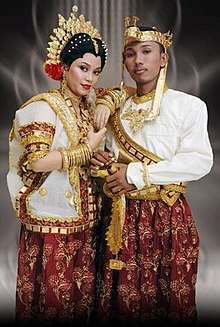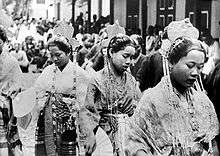Buginese people
The Buginese or Bugis people are an ethnic group—the most numerous of the three major linguistic and ethnic groups of South Sulawesi (the others being Makassar and Toraja), in the southwestern province of Sulawesi, third largest island of Indonesia.[5] The Austronesian ancestors of the Bugis people settled on Sulawesi around 2500 B.C.E. There is "historical linguistic evidence of some late Holocene immigration of Austronesian speakers to South Sulawesi from Taiwan"—which means that the Buginese have "possible ultimate ancestry in South China", and that as a result of this immigration, "there was an infusion of an exogenous population from China or Taiwan."[6] Migration from South China by some of the paternal ancestors of the Bugis is also supported by studies of Human Y-chromosome DNA haplogroups.[7] The Bugis in 1605 converted to Islam from Animism.[8] The main religion embraced by the Bugis is Islam. There are a small number of Bugis who do not take Islam as their religion. Some Bugis converted to Christianity by means of marriage but their number remained small. A Bugis community living in Amparita in the Sidenreng Rappang Regency remains in pre-Islamic belief and is called as Tolotang.[9]
 Buginese couple in traditional costume during their wedding | |
| Total population | |
|---|---|
| 6 million (2010 census) | |
| Regions with significant populations | |
| 6,359,700[1] | |
| | 3,618,683 |
| | 735,819 |
| | 496,432 |
| | 409,741 |
| | 144,554 |
| | 137,282 |
| | 107,159 |
| | 101,727 |
| | 96,145 |
| | 88,991 |
| | 68,227 |
| | 40,087 |
| 144,000 | |
| 11,000 | |
| Languages | |
| Buginese Malay (predominantly Indonesian, but also the Malaysian variant) | |
| Religion | |
| 95% Sunni Islam[2][3] with Christian and Tolotang minorities[4] | |
| Related ethnic groups | |
| Makassar people, Mandarese people, Toraja | |
a An estimated 3,500,000 claim Buginese descent. | |
Despite the population numbering only around 6 million, the Bugis are influential in the politics in modern Indonesia, and historically influential on the Malay peninsula and other parts of the archipelago where they have migrated, starting in the late seventeenth century. The third president of Indonesia, B.J. Habibie (1998-1999), and the former Vice President of Indonesia, Jusuf Kalla were Bugis, sixth Prime Minister, Najib Razak and current Prime Minister of Malaysia, Muhyiddin Yassin has Bugis ancestry.
Although many Bugis people live in the large port cities of Makassar and Parepare, the majority are farmers who grow wet rice on the lowland plains to the north and west of the town of Maros. The name Bugis is an exonym which represents an older form of the name; (To) Ugi is the endonym.[10]
The Bugis people speak a distinct regional language in addition to Indonesian, called Basa Ugi, Bugis or Bugis. In reality, there are several dialects, some of which are sufficiently different from others to be considered separate languages. The Bugis language belongs to the South Sulawesi language group; other members include the Maksar language, Torajan, Mandar and Enrekang, each being a series of dialects.[11]
History
_met_hofdames_TMnr_10001333.jpg)
Origin
Homeland in Sulawesi, Indonesia
The homeland of the Buginese is the area around Lake Tempe and Lake Sidenreng in the Walannae Depression in the southwest peninsula of Sulawesi. It was here that the ancestors of the present-day Bugis settled, probably in the mid- to late second millennium BC. The area is rich in fish and wildlife and the annual fluctuation of Lake Tempe (a reservoir lake for the Bila and Walannae rivers) allows speculative planting of wet rice, while the hills can be farmed by swidden or shifting cultivation, wet rice, gathering and hunting. Around AD 1200 the availability of prestigious imported goods including Chinese and Southeast Asian ceramics and Gujerati print-block textiles, coupled with newly discovered sources of iron ore in Luwu stimulated an agrarian revolution which expanded from the great lakes region into the lowland plains to the east, south and west of the Walennae depression. This led over the next 400 years to the development of the major kingdoms of South Sulawesi, and the social transformation of chiefly societies into hierarchical proto-states.[12]
Migration to other areas
Malay Peninsula and Sumatra

The conclusion in 1669 of a protracted civil war led to a diaspora of Bugis and their entry into the politics of the Malay Peninsula and Sumatra. The Bugis played an important role in defeating Jambi and had a huge influence in Sultanate of Johor. Apart from the Malays, another influential faction in Johor at that time was the Minangkabau. Both the Buginese and the Minangkabau realised how the death of Sultan Mahmud II had provided them with the chance to exert power in Johor. Under the leadership of Daeng Parani, the descendants of two families settled on the Linggi and Selangor rivers and became the power behind the Johor throne, with the creation of the office of the Yang Dipertuan Muda (Yam Tuan Muda), or Bugis underking.[13]
In northern Australia
Long before European colonialists extended their influence into these waters, the Makassarese, the Bajau, and the Buginese built elegant, ocean-going schooners in which they plied the trade routes. Intrepid and doughty, they travelled as far east as the Aru Islands, off New Guinea, where they traded in the skins of birds of paradise and medicinal masoya bark, and to northern Australia, where they exchanged shells, birds'-nests and mother-of-pearl for knives and salt with Aboriginal tribes.
The Buginese sailors left their mark and culture on an area of the northern Australian coast which stretches over two thousand kilometres from the Kimberley to the Gulf of Carpentaria. Throughout these parts of northern Australia, there is much evidence of a significant Bugis presence. Each year, the Bugis sailors would sail down on the northwestern monsoon in their wooden padewakang. They would stay in Australian waters for several months to trade and take trepang (or dried sea cucumber) before returning to Makassar on the dry season off shore winds.
As Thomas Forrest wrote in A Voyage from Calcutta to the Mergui Archipelago (1792), S.78 ff., “The Buggesses in general are a high-spirited people; they will not bear ill usage... They deserve the character given of Malays in general, by Monsieur Poivre, in his Travels of a Philosopher, 'fond of adventures, emigration, and capable of undertaking the most dangerous enterprizes'.”
Lifestyle

Most present-day Buginese now earn their living as rice farmers, traders or fishermen. Women help with the agricultural cycle and work in the homes.
Most Bugis people live in stilted houses, sometimes three meters (9 ft) or more off the ground, with plank walls and floors.
Many of the marriages are still arranged by parents and ideally take place between cousins. The Bugis recognise a cousin up to the ninth degree. A newlywed couple often lives with the wife's family for the first few years of their marriage (matrilocal).
The Bugis diet consists mainly of rice, maize, fish, chicken, vegetables, fruit and coffee. On festive occasions, goat is served as a special dish.
It has been argued that the Bugis people recognise five separate genders.[14] These are makkunrai and oroané, which are similar to cisgender male and female respectively, as well as calabai, calalai, and bissu, which are less easily comparable to Western ideas of gender.[15]
Religion
A few west coast rulers converted to Christianity in the mid-16th century, but failure by the Portuguese at Malacca to provide priests meant that this did not last. In the early 17th century, the Minangkabau ulama, Dato Ri Bandang, Dato Ri Tiro, and Dato Ri Patimang spread Islam in South Sulawesi.[16] The Bugis converted from indigenous animistic practices and beliefs to Islam. By 1611, all the Makasar and Bugis kingdoms had converted to Islam. According to Nurman Said 95% of the Bugis are Muslims. There are a small number of Bugis who do not take Islam as their religion. Some Bugis converted to Christianity by means of marriage but their number remained small. A Bugis community living in Amparita in the Sidenreng Rappang Regency remains in pre-Islamic belief and is called as Tolotang.[9]
Because most Bugis people are Muslims, the Hajj is seen as a prestige by them.
In literature
A settlement of Bugis people in the fictional country of Patusan plays a key role in Joseph Conrad's novel Lord Jim.
Notable people
- Abdul Razak Hussein, 2nd Prime Minister of Malaysia and father of Najib Razak.
- Sultan Salehuddin Shah ibni Almarhum Daeng Chelak, the 1st sultan of the sultan of Selangor in Malaysia.
- Abu Bakar of Johor, the 21st sultan of the Johor Sultanate in Malaysia.
- Amir Syamsuddin, former Minister of Justice and Human Rights of Indonesia (2011–2014).
- Andi Muhammad Ghalib, Attorney General of Indonesia (1998–1999), Ambassador to India (2008–2013)[17]
- Erna Witoelar, former Minister of Human Settlements and Regional Development of Indonesia.
- Jusuf Kalla, Vice President of Indonesia.
- Ma'mun Sulaiman, Malaysian Politician
- Lisa Surihani, Malaysian actress, model, television host and commercial model.
- Muhyiddin Yassin, current president of Parti Pribumi Bersatu Malaysia party and former Deputy Prime Minister of Malaysia and member of United Malays National Organisation party.
- Najib Razak, 6th Prime Minister of Malaysia.
- Osman Jamal, Sabahan Politician
- Raja Ali Haji, a 19th-century historian, poet and scholar.
- Saripudin Hatta, Sabahan politician
- Taufik Batisah, Singaporean singer.
- Ziana Zain, Malaysian singer.
- Once Mekel (born Elfonda Mekel), stage name of Indonesian singer.
See also
- Spread of Islam in Southeast Asia
- Bugis in Singapore
- Demographics of Indonesia
- Demographics of Malaysia
Notes
References
- Akhsan Na'im, Hendry Syaputra (2011). Kewarganegaraan, Suku Bangsa, Agama dan Bahasa Sehari-hari Penduduk Indonesia Hasil Sensus Penduduk 2010. Badan Pusat Statistik. ISBN 9789790644175.
- BUGIS RELIGION
- Religion and Cultural Identity Among the Bugis (A Preliminary Remark)
- Said, Nurman (Summer 2004). "Religion and Cultural Identity Among the Bugis (A Preliminary Remark)" (PDF). Inter-Religio (45): 12–20.
- Michael G. Peletz, Gender pluralism: southeast Asia since early modern times. Routledge, 2009. ISBN 0-415-93161-4
- Susan G. Keates, Juliette M. Pasveer, Quaternary Research in Indonesia. Taylor & Francis, 2004. ISBN 90-5809-674-2
- Li, H; Wen, B; Chen, SJ; et al. (2008). "Paternal genetic affinity between Western Austronesians and Daic populations". BMC Evol. Biol. 8: 146. doi:10.1186/1471-2148-8-146. PMC 2408594. PMID 18482451.
- Keat Gin Ooi, Southeast Asia: A Historical Encyclopedia, From Angkor Wat to East Timor. ABC-CLIO, 2004. ISBN 1-57607-770-5
- Said, Nurman (Summer 2004). "Religion and Cultural Identity Among the Bugis (A Preliminary Remark)" (PDF). Inter-Religio (45): 12–20.
- Shiv Shanker Tiwary & Rajeev Kumar (2009). Encyclopaedia of Southeast Asia and Its Tribes, Volume 1. Anmol Publications. p. 47. ISBN 978-81-261-3837-1.
- Mills, R.F. 1975. Proto South Sulawesi and Proto Austronesian phonology. Ph. D thesis, University of Michigan.
- Caldwell, I. 1995. 'Power, state and society among the pre-Islamic Bugis.' Bijdragen tot de Taal-, Land- en Volkenkunde 151(3): 394-421; Bulbeck, D. and I. Caldwell 2000. Land of iron; The historical archaeology of Luwu and the Cenrana valley. Hull: Centre for South-East Asian Studies, University of Hull.
- "History", Embassy of Malaysia, Seoul Archived 30 April 2008 at the Wayback Machine
- "Archived copy". Archived from the original on 28 July 2012. Retrieved 2011-07-25.CS1 maint: archived copy as title (link)
- Graham, Sharyon (1 July 2004). "It's like one of those puzzles: Conceptualizing gender among Bugis". Journal of Gender Studies. 13 (2): 107–116. doi:10.1080/0958923042000217800.
- Naim, Mochtar. Merantau.
- Loveard, Dewi (25 June 1999). "Target: The Attorney General Andi Ghalib is himself the subject of a probe". Asiaweek. Retrieved 7 June 2016.
- Joshua Eliot (1993). Indonesia, Malaysia & Singapore Handbook. Trade & Trade & Travel Publications. p. 363. ISBN 09-007-5142-8.
Further reading
- Christian Pelras (1996), The Bugis, Backwell Publishing, ISBN 978-0-631-17231-4
External links
| Wikisource has the text of the 1911 Encyclopædia Britannica article Bugis. |
| Wikimedia Commons has media related to Bugis people. |